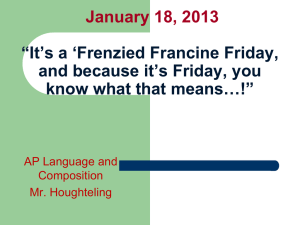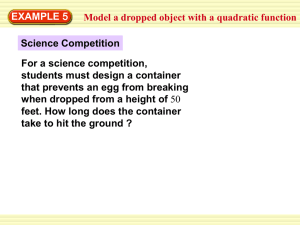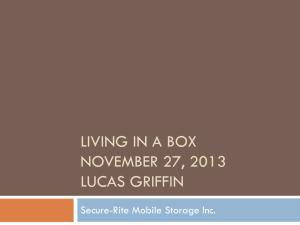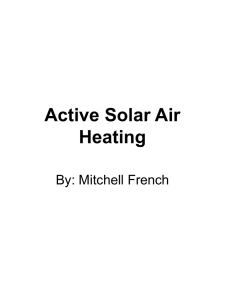Terminology, EPA Regulations and Pesticide Labels
advertisement
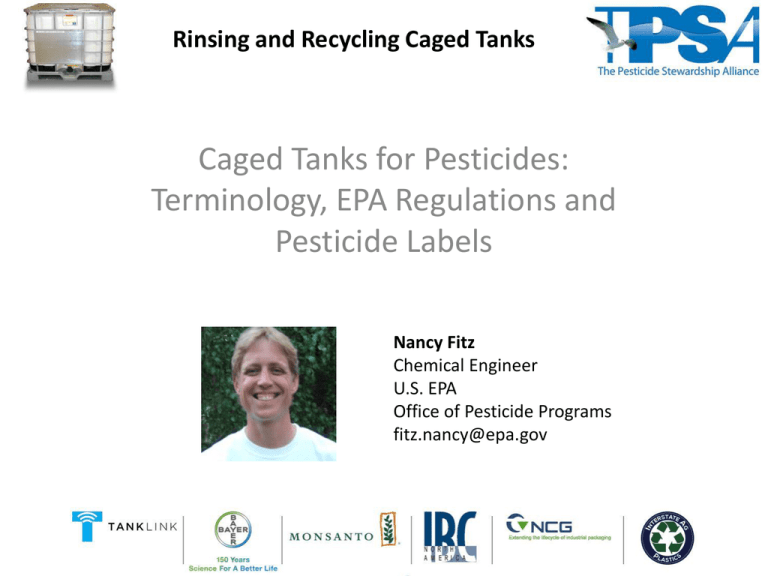
Rinsing and Recycling Caged Tanks Caged Tanks for Pesticides: Terminology, EPA Regulations and Pesticide Labels Nancy Fitz Chemical Engineer U.S. EPA Office of Pesticide Programs fitz.nancy@epa.gov Rinsing and Recycling Caged Tanks Container Terminology • Intermediate bulk container (IBC) – DOT term; containers > 119 gallons & designed for mechanical handling • Portable refillable container (PRC) – EPA term; containers intended to be filled with a pesticide more than once & are portable • Mini bulk or shuttle – Industry terms for pesticide containers that are refilled with pesticide Rinsing and Recycling Caged Tanks Container Terminology • Asset tank • Rotationally molded polyethylene tank • Composite IBC • Tote • Caged tank Rinsing and Recycling Caged Tanks Container Terminology • Retrofit: modify a container to bring it into compliance, e.g., add a one-way valve to a mini bulk/IBC • Refill: fill a container with pesticide more than once; generally within the pesticide distribution chain Rinsing and Recycling Caged Tanks Container Terminology • Recondition: clean, test, repair & otherwise modify containers so they can be used again; containers generally go outside the pesticide distribution chain • Recycle: discarded materials are converted into raw materials and used in the production of new products; end of service for the container Rinsing and Recycling Caged Tanks EPA’s Pesticide Container Regulations • Went into full effect in August 2011 • Split pesticide containers into two types: nonrefillable and refillable • Requirements for container design & repackaging • New label instructions – reuse, recycling & rinsing. Rinsing and Recycling Caged Tanks Container Types • Nonrefillable container: designed & constructed for one-time use and not intended to be filled again with a pesticide for sale or distribution. • Refillable container: intended to be filled with pesticide more than once for sale or distribution Rinsing and Recycling Caged Tanks If the caged tank is a refillable container… Rinsing and Recycling Caged Tanks Portable refillable containers must: • Comply with the U.S. DOT standards that EPA adopted (generally Packing Group III) • Be durably marked with a serial number/ identifying code • Have a tamper-evident device or a one-way valve (or both) on each opening other than a vent • Be sound (in good condition). Rinsing and Recycling Caged Tanks Key Points for Growers • Refillers can only refill PRCs that meet those standards (regardless of container owner). – If you own mini bulks (that are refilled), they must comply! • Refillers must clean containers if a tamper-evident device or one-way valve is broken. – Tamper-evident devices & one-way valves should be intact when you return mini bulks for refill! – One exception: Unless refiller specifically directs you to rinse the container (& provides instructions). Rinsing and Recycling Caged Tanks If the caged tank is a nonrefillable container… Rinsing and Recycling Caged Tanks Key Points for Growers • The container may be subject to container standards (based on product): DOT requirements & standard closure size. • Label instructions: – “Nonrefillable container. Do not reuse or refill this container.” – How to clean the container – “Offer for recycling if available or…” Rinsing and Recycling Caged Tanks Sample Label Instructions STORAGE AND DISPOSAL Do not contaminate water, food, or feed by storage or disposal. PESTICIDE STORAGE: Do not store near fertilizers or seeds. … PESTICIDE DISPOSAL: Wastes resulting from the use of this product may be disposed of on site or at an approved waste disposal facility. CONTAINER DISPOSAL: … Rigid, Non-refillable containers that are too large to shake (i.e., with capacities greater than 5 gallons or 50 lbs) Non-refillable Containers – Do not reuse or refill this container. Refer to Bottom Discharge IBC or Top Discharge IBC, Drums, Kegs information as follows. Bottom Discharge IBC (e.g., - Schuetz Caged IBC or Snyder Square Stackable) Pressure rinsing the container before final disposal is the responsibility of the person disposing of the container. To pressure rinse the container before final disposal, empty the remaining contents from the IBC into application equipment or mix tank. Raise the bottom of the IBC by 1.5 inches on the side which is opposite of the bottom discharge valve to promote more complete product removal. Completely remove the top lid of the IBC. Use water pressurized to at least 40 PSI to rinse all interior portions. Continuously pump or drain rinsate into application equipment or rinsate collection system while pressure rinsing. Continue pressure rinsing for 2 minutes or until rinsate becomes clear. Replace the lid and close bottom valve. … Once container is rinsed, offer for recycling if available or puncture and dispose of in a sanitary landfill. Rinsing and Recycling Caged Tanks Cleaning Guidance • Safely Cleaning and Preparing Large Pesticide Containers for Recycling (> 55 gallons) • Prepared by CropLife America, Ag Container Recycling Council & TPSA • Covers and Environmental Health & Safety review as well as steps for cleaning and preparing the container for recycling Rinsing and Recycling Caged Tanks Questions?


